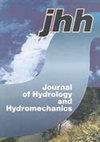Estimation of hydrodynamic properties of a sandy-loam soil by two analysis methods of single-ring infiltration data
IF 2.4
4区 环境科学与生态学
Q3 WATER RESOURCES
引用次数: 0
Abstract
Abstract Beerkan infiltration runs could provide an incomplete description of infiltration with reference to either the near steady-state or the transient stages. In particular, the process could still be in the transient stage at the end of the run or some transient infiltration data might be loss. The Wu1 method and the BEST-steady algorithm can be applied to derive soil hydrodynamic parameters even under these circumstances. Therefore, a soil dataset could be developed using two different data analysis methods. The hypothesis that the Wu1 method and BEST-steady yield similar predictions of the soil parameters when they are applied to the same infiltration curve was tested in this investigation. For a sandy-loam soil, BEST-steady yielded higher saturated soil hydraulic conductivity, Ks, microscopic pore radius, λm, and depth of the wetting front at the end of the run, dwf, and lower macroscopic capillary length, λc, as compared with the Wu1 method. Two corresponding means differed by 1.2–1.4 times, depending on the variable, and the differences appeared overall from moderate to relatively appreciable, that is neither too high nor negligible in any circumstance, according to some literature suggestions. Two estimates of Ks were similar (difference by < 25%) when the gravity-driven vertical flow and the lateral capillary components represented the 71–89% of total infiltration. In conclusion, the two methods of data analysis do not generally yield the same predictions of soil hydrodynamic parameters when they are applied to the same infiltration curve. However, it seems possible to establish what are the conditions making the two methods similar.用两种单环入渗数据分析方法估算沙壤土的水动力特性
摘要Beerkan渗透运行可以参考接近稳态或瞬态阶段提供对渗透的不完整描述。特别是,该过程可能在运行结束时仍处于瞬态阶段,或者一些瞬态渗透数据可能丢失。即使在这种情况下,Wu1方法和BEST稳态算法也可以用于推导土壤水动力参数。因此,可以使用两种不同的数据分析方法来开发土壤数据集。本研究检验了Wu1方法和BEST稳态产量对土壤参数的预测相似的假设,当它们应用于相同的入渗曲线时。对于沙壤土,与Wu1方法相比,BEST稳定产生更高的饱和土壤导水率Ks、微观孔隙半径λm和运行结束时的湿润锋深度dwf,以及更低的宏观毛细管长度λc。根据一些文献建议,根据变量的不同,两个相应的平均值相差1.2-1.4倍,总体上从中等到相对可观,在任何情况下都不算太高,也不可忽略。当重力驱动的垂直流和侧向毛细管成分占总渗透的71–89%时,Ks的两个估计值相似(相差<25%)。总之,当将这两种数据分析方法应用于相同的入渗曲线时,它们通常不会对土壤水动力参数产生相同的预测。然而,似乎有可能确定是什么条件使这两种方法相似。
本文章由计算机程序翻译,如有差异,请以英文原文为准。
求助全文
约1分钟内获得全文
求助全文
来源期刊
CiteScore
4.20
自引率
5.30%
发文量
30
审稿时长
>12 weeks
期刊介绍:
JOURNAL OF HYDROLOGY AND HYDROMECHANICS is an international open access journal for the basic disciplines of water sciences. The scope of hydrology is limited to biohydrology, catchment hydrology and vadose zone hydrology, primarily of temperate zone. The hydromechanics covers theoretical, experimental and computational hydraulics and fluid mechanics in various fields, two- and multiphase flows, including non-Newtonian flow, and new frontiers in hydraulics. The journal is published quarterly in English. The types of contribution include: research and review articles, short communications and technical notes. The articles have been thoroughly peer reviewed by international specialists and promoted to researchers working in the same field.

 求助内容:
求助内容: 应助结果提醒方式:
应助结果提醒方式:


